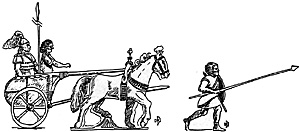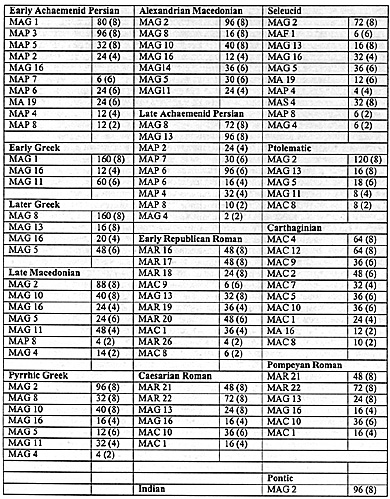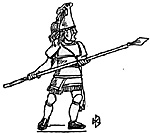 A game of using figures or counters on a grid terrain.
A game of using figures or counters on a grid terrain.
A. Legion is a historical game system which is designed to simulate any of the following 36 different Greek and Roman battles from the last 5 centuries BC. Armies in brackets are from Wargames Research Group Army Lists for the W.R.G. 3000BC to 1485AD - 7th Edition (revised) game system.
i. Persian Battles
- Marathon 490BC Early Greeks vs Early Achaemenid Persian
Plataea 479BC Early Greeks vs Early Achaemenid Persian
Cunaxa 401BC Early Achaemenid Persian vs Early Achaemenid Persian
Granicus 334BC Late Achaemenid Persian vs Alexandrian Macedonian
Issus 333BC Late Achaemenid Persian vs Alexandrian Macedonian
Arbela 331BC Late Achaemenid Persian vs Alexandrian Macedonian
ii. Greek Battles
- Delium 424BC Early Greek vs Early Greek
Mantinea 418BC Early Greek vs Early Greek
Nemea 394BC Later Greek vs Later Greek
Leuctra 371BC Later Greek vs Later Greek
Mantinea 362BC Later Greek vs Later Greek
Chaeronea 338BC Later Greek vs Alexandrian Macedonian
iii. Hellenistic Battles
- Hydaspes 326BC Indian vs Alexandrian Macedonian
Gabiene 316BC Late Macedonian vs Late Macedonian
Gaza 312BC Late Macedonian vs Late Macedonian
Ipsus 301BC Late Macedonian vs Late Macedonian
Sellasia 222BC Late Macedonian vs Pyrrhic Greek
Raphia 217BC Ptolematic vs Seleucid
iv. Punic Battles
- Crimisus 341BC Later Greek vs Carthaginian
Bagradas 255BC Early Republican Roman vs Carthaginian
Trebia 218BC Early Republican Roman vs Carthaginian
Cannae 216BC Early Republican Roman vs Carthaginian
Ilipa 206BC Early Republican Roman vs Carthaginian
Zama 206BC Early Republican Roman vs Carthaginian
v. Mid Republican Roman Battles
- Sentinum 295BC Early Republican Roman vs North Gaulish
Heraclea 280BC Early Republican Roman vs Pyrrhic Greek
Asculum 279BC Early Republican Roman vs Pyrrhic Greek
Cynoscephalae 197BC Early Republican Roman vs Late Macedonian
Magnesia 190BC Early Republican Roman vs Seleucid
Pydna 168BC Early Republican Roman vs Late Macedonian
vi. Late Republican Roman Battles
- Vercellae 101BC Caesarian Roman vs Early German
Chaeronea 86BC Caesarian Roman vs Pontic
Sambre 57BC Caesarian Roman vs North Gaulish
Carrhae 53BC Caesarian Roman vs Parthian
Pharsalus 48BC Caesarian Roman vs Pompeyan Roman
Munda 45BC Caesarian Roman vs Pompeyan Roman
Figure Gaming
 Following are the type and number of Heroics & Ros 1/300 (6mm) miniature figures required to recreate any of the 18 armies listed above. For example, the Early Achaemenid Persian list contains enough stands to field either the army of Datis & Artaphernes, Mardonius, Cyrus or Artaxerxes. Under each army heading are listed the H&R pack code, the number of single figures required and the number of figurines to each unit/stand.
Following are the type and number of Heroics & Ros 1/300 (6mm) miniature figures required to recreate any of the 18 armies listed above. For example, the Early Achaemenid Persian list contains enough stands to field either the army of Datis & Artaphernes, Mardonius, Cyrus or Artaxerxes. Under each army heading are listed the H&R pack code, the number of single figures required and the number of figurines to each unit/stand.
Use a 45mm hex for Legion figure gaming and base to the following sizes:
- Close formation Infantry 40mm x 10mm
Loose or Open formation Infantry 40mm x 15mm
Cavalry or Camelry 40mm x 20mm
Elephants or Chariots 40mm x 30mm


iii. The number of figures per unit in Legion is unimportant for play because the unit is the basic element in the game. The number of figures per stand is crucial for W.R.G. 3000BC - 1485AD tactical gaming. I have therefore designed the Legion armies with the WRG base specifications. This will not cause any negative effect to the Legion system and will allow anyone who wants to delve into W.R.G. tactical, to do so. The figures listed above for the 18 armies make excellent core armies for W.R.G. and further units can be added later to increase selection.
C. Campaigns.
Following are all the major campaigns covered by the Legion timespan (500BC - 0BC):
- Great Persian War, 480BC
Bactrian Empire, 250BC
Rise of Rome, 358BC
1st Punic War, 264BC
Alexander the Great, 334BC
2nd Punic War, 218BC
Diadochi, 321BC
Marian Roman, 88BC
Pyrrhic, 280BC
Caesarian Roman, 58BC
Galatian Invasion, 279BC
Refer to De Bellis Antiquitatis (W.R.G.) for details of the armies involved in each campaign.
D. The Battlefield
The battle area for Legion is hex shaped, with a superimposed hex grid. The following terrain modules are used to simulate the various historical battlefields. Legion is hex based, i.e. "the hexes rationalise the infinite possible variations of terrain and troop positioning, hence doing away with measuring errors and removing the need for constant discussions or gamesmaster adjudication about rule interpretations in specific cases". The Units. The number of troops represented by each unit depends on the type of unit and on the size of the historical battle concerned, as follows.
- Type Number of Troops, Vehicles or Beasts
Heavy Infantry 400 - 6000
Medium Infantry 400 - 6000
Light Infantry 200 - 3000
Heavy Cavalry 100 - 1500
Medium Cavalry 100 - 1500
Light Cavalry 100 - 1500
Cataphracts 200 - 3000
2 - Horse Fighting Chariots 40 - 600
4 - Horse Fighting Chariots 20 - 300
Anti - Elephant Ox wagons 20 - 300
Scythed Chariots 5 - 75
Unaccompanied Elephants 4 - 60
Escorted Elephants 2 - 30
Levy cavalry and light infantry are combined into deeper double units. Units are described as follows: Unit Class, Facing Indicator (not light troops), Unit Type (listed above), Move allowance (2MP to 5MP) and Points Value (1PV to 4PV). Infantry, cavalry and cataphracts fall into 3 classes, Veteran, Average and Levy; chariots are divided into Fighting and Scythed; elephants into Indian and African; and baggage into Fortified and Unfortified. Generals are of two types - Leaders and Commanders. Both types contain 4 classes: Uninspired, Average, Inspired and Brilliant. Generals have a value from 2PV to 16PV.
iii. Each hex represents from 100 yards to 400 yards ground scale. Each turn in the game represents from 10 minutes to 40 minutes time scale.
F. Sequence of Play
The game is played in turns, each consisting of two player-turns:
i. Command Phase. Dice for command points and place groups of friendly units in command.
ii. Movement Phase. Move your generals and combat units which are in command, in any order, expending spare command points for extra movement.
iii. Resistance Phase. The enemy player launches attacks against your units, which may cause some of your other units to break and rout off the board due to falling morale.
iv. Assault Phase. Launch attacks with any friendly units which are in command, as a result of which certain other enemy units may break and rout off the bound due to falling morale.
 G. Unit Status
G. Unit Status
Units may be in one of five basic conditions:
- Undeployed - Off board.
Deployed - On board.
Withdrawn - Removed safely from battlefield.
Scattered - Dispersed whilst trying to withdraw.
Shattered - Destroyed.
Units begin the game Fresh until enemy attacks or routing friendly troops cause them to become Spent. Spent units which suffer a further hit in combat become shattered and are removed from play immediately.
H. Command
You receive a number of command points at the start of each of your player-turns. These are used to place your combat units "in command", to use extra movement or to boost the chances of friendly assaults.
I. Movement
Whether using counters or figures, manoeuvre in Legion is carried out in classic boardgame style. Certain troop types are penalised in certain circumstances and when encountering difficult terrain. Well thought out restrictions prevent troops behaving or moving unrealistically.
J. Attacks
Each unit attacks individually, but a single enemy unit may be subjected to several successive attacks, which need not be declared in advance. "Attacks represent a wide array of combat interactions including hand-to-hand fighting, missile fire, psychological intimidation, and provoking elusive skirmishers into ineffective missile volleys to the point where they run out of ammunition".
i. To conduct an attack, you first cross-reference the attacking and defending unit types on the combat matrix to find the basic attack rating. You then adjust the basic attack rating depending on the tactical circumstances of the attack. You then roll a D6 and consult the appropriate column of the Combat Results Table. With the built in re-roll system, Legion uses a D36 (3% randomiser increments).
ii. Hits normally cause a unit to degenerate to spent and then shattered. However, if one of your spent units receives a hit, you may transfer the hit by making an adjacent fresh unit of your choice spent instead. This means that "Whole sections of the line generally become spent before any units are shattered, and it helps to transfer combat from unit-on-unit into a line-on-line affair".
K. Morale
The morale of ancient armies was a highly variable phenomenon. Sometimes troops panicked before even coming to grips with the enemy, while at other times they fought on bitterly, even if the bulk of the army had already fled. To reflect this, Legion bases its morale system on testing every time a unit is shattered.
i. First the overall morale of your army is calculated. You must then apply various additional modifiers to work out the specific morale of individual combat units which may panic. Results cause units to remain steady or break. Routed units are removed from the battlefield as either withdrawn or scattered.
ii. Surprise, fatigue and weather are built into the historical scenarios.
L. Special Unit Types
A particularly interesting aspect of ancient warfare is the diversity of troop types which it involved. "It is wrong to place too much stress on minor equipment differences, since variations in troop quality, generalship and tactical circumstances had much more impact on the outcome of actual battles."
However, differences between the fighting styles of particular forces did have some important tactical and even grand tactical consequences, and they were also crucial to the interlocking balance of strengths and weaknesses between different troop types. In no way think of the following troop types as superior to the norm. For every advantage given there is also a penalty or weakness subjected. To reflect these factors, Legion introduces some more specific sub-types of troops into the game. These are: Hoplites, Phalangites, Legionaries, Swordsmen, Archers and Armoured Cavalry.
M. Victory
Play normally ceases as soon as either player's combat and baggage units and generals are all shattered, scattered, withdrawn or dead, or at nightfall. Victory is based on points value differential and any of the following results are obtainable:
| Outcome | Victory Points | |
|---|---|---|
| Stunning Defeat | 0 | |
| Resounding Defeat | 1 | |
| Major Defeat | 2 | |
| Clear Defeat | 3 | |
| Narrow Defeat | 4 | |
| Narrow Victory | 5 | |
| Clear Victory | 6 | |
| Major Victory | 7 | |
| Resounding Victory | 8 | |
| Stunning Victory | 9 |
ii. The many different levels of victory and defeat mean that, even if you are clearly getting the worst of the battle, it is worth doing all you can to hang on until nightfall or to withdraw your units intact rather than have them encircled and shattered.
N. Tournament Game
These rules allow you to fight an almost infinite range of different battles. Choose any two of the 72 different armies to face each other. The game plays perfectly well whatever match-up you use. Then dice for baggage, one of the 36 historical terrain layouts, number of turns, weather, fatigue and surprise. Play then commences. Legion has a fast set-up time.O. Conclusion
I have thoroughly playtested Legion and can find no faults. The game has atmosphere, achieves realistic results, is fast playing (two experienced players could finish a game in just one session) and, most importantly, is great fun to play. Full credit to Philip Sabin, a Classic![Input by Ian (Turbo Type) Duncan] [Legion is available, cost £ 5 include P&P, from Peter and Alison Woodland, 24 Consort Rd, Eastleigh, Hants, S050 4JB. Tel: 01703615967. Kenn]
Back to Table of Contents -- Lone Warrior #125
Back to Lone Warrior List of Issues
Back to MagWeb Magazine List
© Copyright 1999 by Solo Wargamers Association.
This article appears in MagWeb (Magazine Web) on the Internet World Wide Web.
Other military history articles and gaming articles are available at http://www.magweb.com
